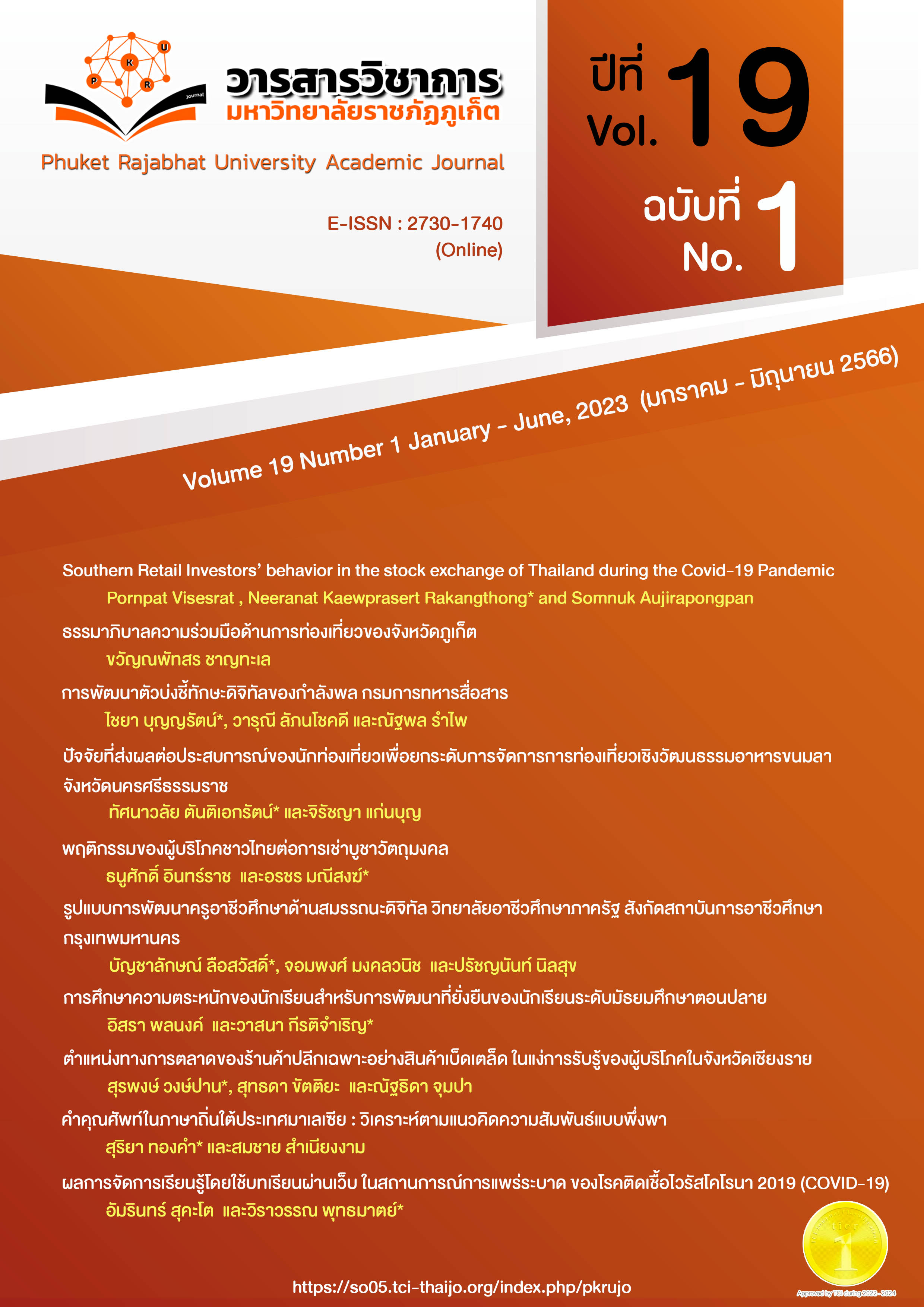ตำแหน่งทางการตลาดของร้านค้าปลีกเฉพาะอย่างสินค้าเบ็ดเตล็ด ในแง่การรับรู้ของผู้บริโภคในจังหวัดเชียงราย
Main Article Content
บทคัดย่อ
งานวิจัยนี้มีวัตถุประสงค์เพื่อศึกษาการรับรู้ตำแหน่งทางการตลาดของตราสินค้าร้านค้าปลีกเฉพาะอย่างสินค้าเบ็ดเตล็ดในจังหวัดเชียงราย จำนวน 5 ร้านค้า ได้แก่ ร้านไดโซะ ร้านโมชิ โมชิ ร้านมินิโซ ร้านวัท และร้านมิสเตอร์ ดี ไอ วาย เป็นการวิจัยเชิงปริมาณ โดยเก็บข้อมูลจากผู้บริโภคที่รู้จักร้านค้าทั้ง 5 ร้านค้าในจังหวัดเชียงราย จำนวน 400 คน แล้ววิเคราะห์ข้อมูลด้วยการวิเคราะห์พหุมิติ โดยแสดงผลด้วยแผนภาพการรับรู้ ผลการวิจัยพบว่า การรับรู้ของผู้บริโภคแบ่งออกเป็น 3 กลุ่ม ได้แก่ กลุ่มที่ 1 ร้านโมชิ โมชิ และร้านมินิโซ ผู้บริโภครับรู้ว่ามีความเหมือนหรือคล้ายคลึงกันและมีแนวโน้มเป็นคู่แข่งขันกันโดยตรงมากที่สุด โดยเป็นร้านค้าที่จำหน่ายสินค้ากลุ่มดีไซน์เฉพาะในรูปแบบราคาที่หลากหลาย กลุ่มที่ 2 ร้านไดโซะ และร้านมิสเตอร์ ดี ไอ วาย ผู้บริโภครับรู้ว่ามีความเหมือนหรือคล้ายคลึงกันและมีแนวโน้มเป็นคู่แข่งขันกัน แต่ไม่ได้เป็นคู่แข่งขันกับกลุ่มที่ 1 และ 3 โดยเป็นร้านค้าที่จำหน่ายสินค้าในรูปแบบราคาหลากหลาย และจำหน่ายสินค้ากลุ่มสินค้าทั่วไป ซึ่งสามารถหาซื้อได้จากร้านอื่น ๆ เช่นกัน และกลุ่มที่ 3 ร้านวัท ผู้บริโภครับรู้ว่ามีความแตกต่างและไม่ได้เป็นคู่แข่งขันกับกลุ่มที่ 1 และ 2 โดยเป็นร้านค้าที่จำหน่ายสินค้าส่วนใหญ่ในรูปแบบราคาเดียว และจำหน่ายสินค้ากลุ่มดีไซน์เฉพาะ
Article Details

อนุญาตภายใต้เงื่อนไข Creative Commons Attribution-NonCommercial-NoDerivatives 4.0 International License.
เนื้อหาและข้อมูลในบทความที่ลงตีพิมพ์ในวารสารวิชาการมหาวิทยาลัยราชภัฏภูเก็ต ถือเป็นข้อคิดเห็นและความรับผิดชอบของผู้เขียนบทความโดยตรง ซึ่งกองบรรณาธิการวารสารฯ ไม่จำเป็นต้องเห็นด้วยหรือร่วมรับผิดชอบใด ๆ
บทความ ข้อมูล เนื้อหา รูปภาพ ฯลฯ ที่ได้รับการตีพิมพ์ในวารสารวิชาการมหาวิทยาลัยราชภัฏภูเก็ต ถือเป็นลิขสิทธิ์ของวารสารวิชาการมหาวิทยาลัยราชภัฏภูเก็ต หากบุคคลหรือหน่วยงานใดต้องการนำทั้งหมดหรือส่วนหนึ่งส่วนใดไปเผยแพร่ต่อหรือเพื่อกระทำการใด ๆ จะต้องได้รับอนุญาตเป็นลายลักษณ์อักษรจากวารสารวิชาการมหาวิทยาลัยราชภัฏภูเก็ตก่อนเท่านั้น
เอกสารอ้างอิง
Anawatchamongcol, S. (2014). Market Positions of European Football Clubs in the Perception of Customers in Urban Khon Kaen. [Master's thesis]. Khon Kaen University.
Brand Buffet. (2018). Looking Back on the Success of Miniso, from the Beginning to an Investment of 100 Million Yuan. Retrieved May 25, 2020, from https://bit.ly/2Z3H0pF
Chaichana, K., & Sangroengrob, T. (2020). Brand Positioning of the Food Delivery Service Through Consumers Perceptions in Bangkok. Journal of KMITL Business School, 10(2), 127-141.
Chaiwiboonvet, R. (2018). Get to know MR.D.I.Y., a Sundries Shop from Malaysia. Compete 20 Baht Shop with a Starting Price of 5 Baht. Retrieved May 25, 2020, from https://brandinside.asia/mr-diy-retail-from-malaysia
Chumpa, N., Chaiphawang, K., & Khattiya, S. (2021). Context of Using Services, Competitive Strategies and Brand Personalities of Modern Retail Business Affecting Consumer Loyalty: A Case Study of Modern Retail Business in Chiang Rai Province. Journal of Legal Entity Management and Local Innovation, 7(4), 263-276.
Hair, J. H., Black, W. C., Babin, B. J., and Anderson, R. E. (2014). Multivariate Data Analysis. Pearson Education.
Inpajorn, P. (2019). Moshi Moshi Japanese Brand. Retrieved May 25, 2020, from https://prezi.com/p/zoyztelrpgmk/moshi-moshi
Komchadluek. (2019). Komonoya Celebrates its 10th Anniversary of Success. Retrieved May 25, 2020, from https://www.komchadluek.net/news/economic/366497
Kotler, P. (2003). Marketing Management. New Jersey: Prentice-Hall.
Lertpai-ngam, K. (2008). Brand Positioning. I M Book.
Longtunman1. (2017). Daiso 60 Baht, Income 100 Billion. Retrieved May 25, 2020, from https://www.longtunman.com/3147
Longtunman2. (2017). MINISO, a New and Hot Store. Retrieved May 25, 2020, from https://www.longtunman.com/2849
Meethawornkul, S. (2012). Product Positioning. Teaching Documents for Professional Marketing Experience Courses. Nonthaburi: Sukhothai Thammathirat University.
Muang-Ngam, R. (2019). 10 Facts You Didn't Know About Mr. D.I.Y. Retrieved May 25, 2020, from https://bit.ly/2EXGN0e
Sratongwian, A. (2010). Retail Business in Thailand. Executive Journal, 30(3), 134-142.
Srichookiat, S., Promsa-ad, S., & Noourai, N. (2015). Market Positioning of Various Retail Formats: Case Study of Hatyai District Songkhla Province. Parichat Journal, 28(3), 214-228.
Srila, S. (2018). A Case Study of Daiso: Mr. Yano Hirotake, a Man Who Failed to do Anything, Turned into a Multi-Million Dollar Business. Retrieved May 25, 2020, from https://bit.ly/32LPRgE
Sriwong, M. (2019). Want to Buy Moshi Moshi Franchise, Japanese Brand Products, Must Read. Retrieved May 25, 2020, from https://bit.ly/3lVpjTc
Tassanawat, S. (2013). Market Positions of Big Retailers in the Perception of Customers in Urban Khon Kaen: The Comparison Between Frequent Users and Infrequent Users. [Master's thesis]. Khon Kaen University.
Techanirattisai, V. (2020). Marketing Strategies to Support Thailand 4.0 Standards. Western University Research Journal of Humanities and Social Science, 6(2), 232-243.
Thailand Development Research Institute. (2017). Wholesale and Retail Business Research Project to Prepare for Drafting Wholesale and Retail Business Laws Suitable for Thailand. Thailand Development Research Institute.
Thanormnaimuang, T., & Sangroengrob, T. (2019). Brand Positioning of the Home Furniture Through Consumers Perceptions in Thailand. Veridian E-Journal, Silpakorn University (Humanities, Social Sciences and arts), 12(6), 339-359.
Tubchula, K. (2014). Local Convenience Stores Success in Bangkok Metropolis. Academic Journal Bangkokthonburi University, 3(2), 108-119.
Walker, Jr. C. O., & Mullins, W. J. (2011). Marketing Strategy. 7th ed. McGraw-Hill.


